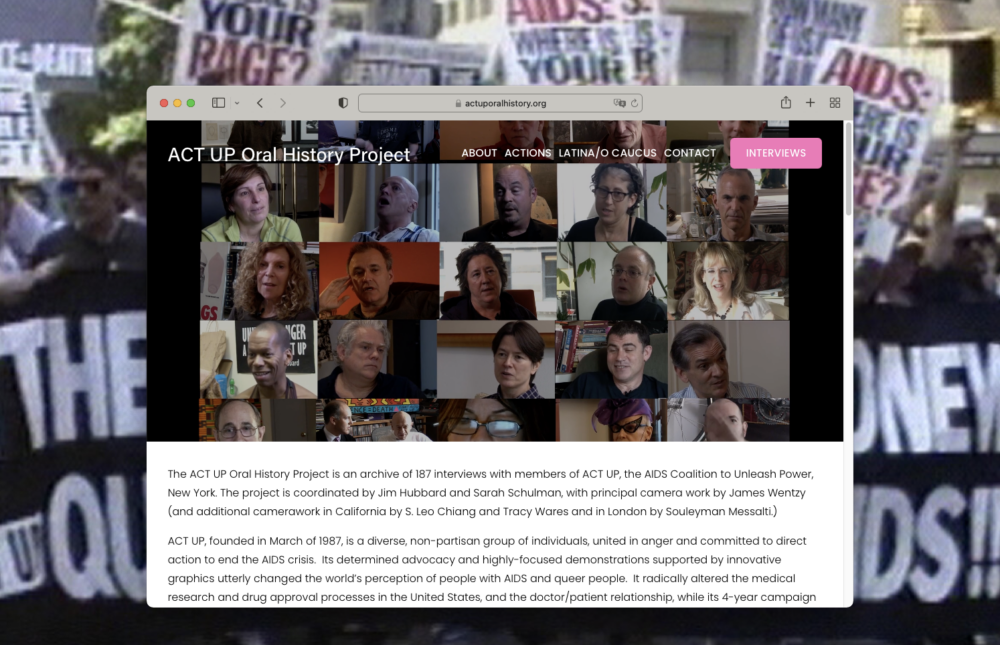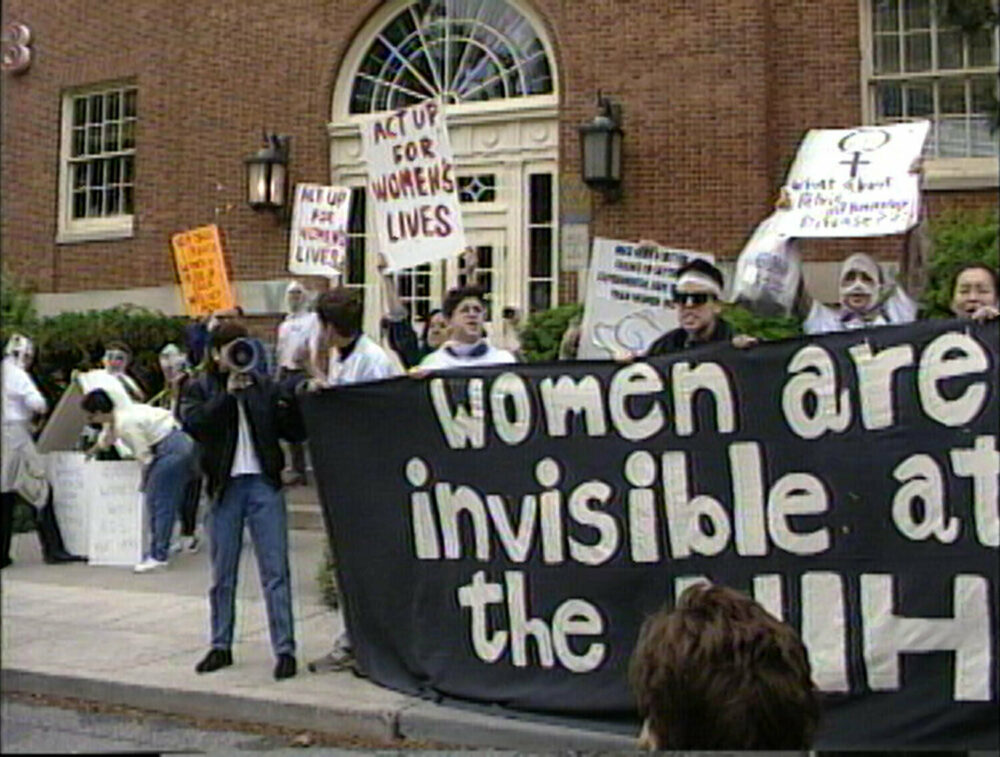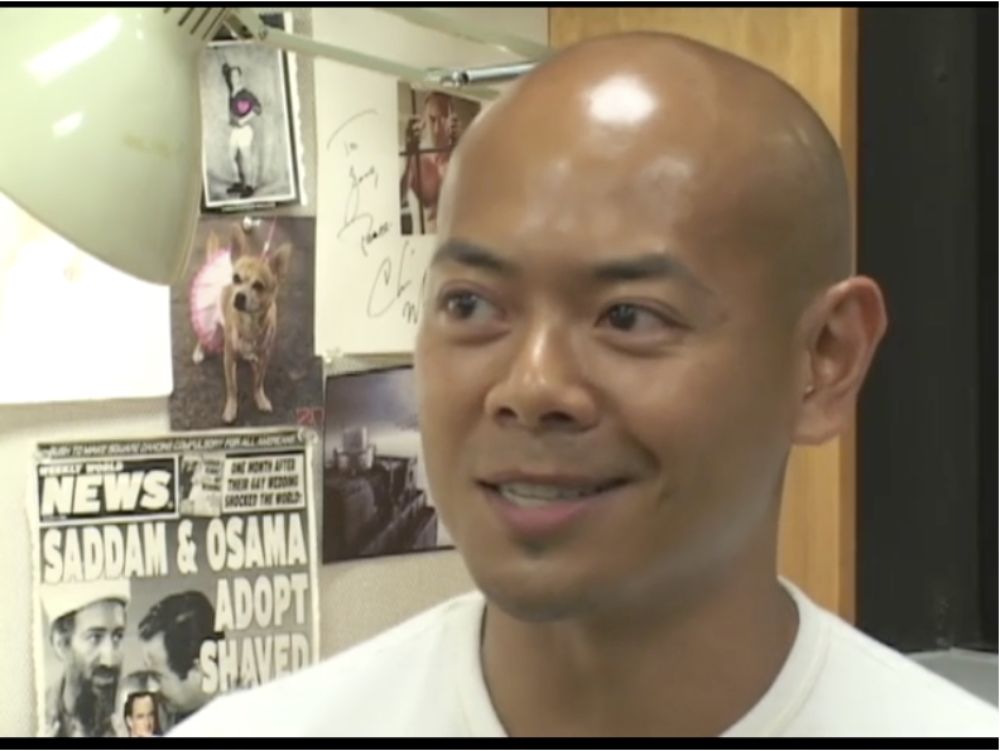The goal of the project is not to glorify ACT UP and its actions. Rather, it is to allow media narratives and mainstream history to yield to memory. Names are dropped, disagreements aired, and alienations unpacked. Despite this conflict, or maybe because of it, ACT UP persisted and got things done. I find the project so valuable precisely because it puts this conflict on record.
In October 2020, I spoke with Jim Hubbard, the project’s co-founder. We connected through Facetime. Hubbard was on a getaway in Provincetown, MA; I was in my dorm room in New Haven. What came up first was the decentered-ness that Hubbard asserts “everyone” in ACT UP felt. Hubbard told me that every person he interviewed was “right in the middle of ACT UP.” “They were the facilitators, and some of the most influential people," he says. Regardless of their role, however, the people that Hubbard spoke to felt far from the center. “There's a feeling in ACT UP,” Hubbard told me, searching for the right words. “Nobody felt that they were at the center,” Hubbard said. “Everyone felt that they were on the fringe.” Hubbard couldn't quite explain why. But he thought it had to do with the experience of being queer—of perpetually being marginalized.
When he said this, I started to visualize ACT UP as people orbiting around one another in various degrees of decentered-ness. Each person’s degree of de-centeredness varied with each interaction, according to the relative positionality of the people who constituted each interaction. In this sea of non-normativity, I kept thinking, some were even more non-normative than others. In other words, even the fringe has a fringe.
Case-in-point are the nonwhite, non-male, non-gay members of ACT UP the project records. Samuel Lurie was one of those extra-non-normative members. At the time of his membership in ACT UP, Lurie identified as a lesbian woman. Later in life, Lurie began to identify as a gay trans man. Lurie recalls his double-consciousness as a member of ACT UP. The majority of the gay men around him perceived Lurie as lesbian. Although privately Lurie was identifying with the gay male culture of ACT UP, due to prevailing societal restrictions, he was unable to affiliate with the gay male culture within ACT UP. “I felt lonely as a dyke in ACT UP, and then I [feel] lonely now, you know. I’m a trans guy who transitioned much later, so I don’t have connections to ACT UP now.” The alienation of members of color is vividly described by Robert Vazquez-Pacheco, when he recounts spotting the only other black guy and the Latinx guy across the room at his first meeting: “We stood out, as my grandmother would say, like a fly in a glass of milk.”
That hyper-visibility (or invisibility, rather) of members of color is what facilitated the founding of Majority Action, a committee that put the issues of people of color on the agenda, advocating for the needs of those communities. (The name Majority Action was, of course, a play on words.) Inevitably, the work of Majority Action was highly intersectional, foregrounding women, intravenous drug users, the houseless, and low-income people. Their main issues, as ACT UP historian Deborah Gould writes, were the expansion of the CDC’s definition of AIDS to include women and low-income people, the inclusion of women in experimental drug trials, “needle exchange programs, housing for PWAs, and medical treatment for prisoners with AIDS.”1
In other words, ACT UP was complex. It was white, male, and middle-class, but also contained pockets of diversity—people working to challenge that normativity. But in present-day historicizations of AIDS activism—in films and mainstream newspaper articles—this complexity isn’t always depicted. As has been pointed out by scholar Jih-Fei Cheng, these accounts often only represent a white, male majority carrying out a narrative of biomedical overcoming.2 Lost is the nuance. Oral history, when conducted sensitively and painstakingly, as it is by Schulman, Hubbard, and their collaborators, results in individual recollection of personal experience. There is no singular narrative being foisted on the viewer. There are several hundreds, and they diverge, contradict, and build off of one another. The ACT UP Oral History Project's archive is subjective, susceptible to the losses of time (a common refrain is “I can’t remember), and peppered with tangents. There is a great mass of data: over 180 hour-plus videos accompanied by transcripts. And although this data is carefully catalogued, with helpful metadata tags, it must be waded through. It takes work.
In line with ACT UP’s ethos of direct-action, making sense of the archive requires the direct participation of the visitor.
Misrepresentations of ACT UP propelled the Oral History Project’s inception. Writing in 2003, Schulman explained her reasons for starting the project, venting: “if I saw ACT UP referred to one more time as a white, middle-class, male organization, I was going to lose my mind." I read Schulman’s statement as an expression of exhaustion and frustration—an assertion that there were others and yet they remain unseen, uncounted, and unacknowledged. The ACT UP Oral History Project, in part, emerged out of this frustration.
From its first interview with Robert Vazquez-Pacheco in 2002, the project has endeavored to center the minority members of ACT UP. Hubbard tells me it was intentional to choose an ACT UP member of color as the first interview subject. This centering of minority voices is evident in the way Schulman asks interviewees to reflect on the ways in which race, class, and/or gender may have impacted their experience in ACT UP. “So how did ACT UP relate to gender? How was gender dealt with in ACT UP?,” she prompts Lurie.
My favorite interview comes from Jose Fidelino. Fidelino is Filipino Canadian and was active in ACT UP for less than 18 months, from approximately 1988 to 1989. I find Fidelino’s interview valuable precisely because it contains conflict. Fidelino elucidates and distills many of the fissures in ACT UP—which are repeated in other oral histories by members of the Majority Action committee.
From the get-go, Fidelino foregrounds his experiences of the power imbalances in ACT UP. Fidelino recounts walking in, during his very first meeting, on a group of white men yelling at the only woman in the room. Fidelino started seeking people out, asking if this was “the normal dynamic”. “And they all assured me it wasn’t,” Fidelino says. "But I think they were all lying. {giggle}.” ACT UP worked horizontally: the goal was to have no power structure but rather groups working in tandem, taking action, and dissenting with each other. Despite this ideal of horizontality, Fidelino and others experienced power imbalances. Another ACT UP member, Lei Chou, reflected that if there were A-list and B-list groups, then Majority Action was the D-list.
Another fissure popped up pretty quickly for Fidelino, between “two schools of people”—those who “were focusing on getting the drugs into the bodies,” and the other, less powerful group, who “were focused on getting the bodies just primary access to health care.” The former school was embodied by the Treatment & Data Committee, which later split off from ACT UP in 1992. Majority Action formed the latter group. Majority Action’s main concern was not a cure; they wanted the bare necessities for communities of color: access to information, clinics, and diagnoses. This racially based differential in access was reflected in the fact that people of color, if they were even fortunate enough to get diagnosed, were still dying much faster than their white counterparts.
Fidelino recalls his logic as: secure this primary access for communities of color, and then, maybe then, focus on getting the drugs. But what would happen if one of these goals was accomplished, but not the other? What would happen if T&D got their hands on the drugs—but Majority Action still struggled for primary access? Would ACT UP still fight for communities of color? The stress that Majority Action felt at that time proved prescient. Fidelino laments the irony of the outcome:
“I always thought that if we get the drugs that would cure the AIDS crisis, people would forget that there is an AIDS crisis. And that’s what’s happened. The, the cocktails came out and people started living longer. And all of a sudden, the AIDS crisis isn’t a front-burner issue at all. And people are still getting infected, and people are still dying, and people still have no access to health care. Poor people, people of color, are still dying sooner of AIDS than people who have money and a primary-care physician. And it’s just not talked about.”
The schism over drugs vs. access illustrated a larger difference in opinion about the end goal: what constitutes empowerment. “[A lot of people in ACT UP] wanted the government to take care of them, as the government takes care of any suburban white person,” Fidelino reflects, “But it’s not empowerment. Empowerment is taking the power for yourself, to do for yourself.” Fidelino is articulating the fact that while certain queers have had the ability to become incorporated into traditional power structures and secure governmental protection, other groups have not, and might not ever have that privilege of incorporation.
How, then, to create a strategy that, instead of prioritizing the incorporation of the most well-positioned, prioritizes the needs of the most vulnerable?
It was a time of great promise—and many obstacles. Vazquez-Pacheco recalls thinking, with youthful idealism, how the focus on primary access had the power to change society. And yet the divisions in ACT UP weighed these efforts down, taking away energy from fighting the issues at hand. Andrew Velez recalls: “the longer ACT UP survived, the more the fissures and cracks began to appear, so that the things that were really crappy in our society were evident.” “It was this weird dynamic,” Fidelino reflects, “where we spent a lot of our energy just dealing with exclusion within ACT UP.” The complex racial, gender, socioeconomic dynamics—and the tension in reconciling the ensuing conflicts over these issues—made it that much harder for ACT UP to accomplish its goals. There is so much to be learned from these divisions and the efforts to overcome them.
The ACT UP Oral History Project provides a valuable archive that reflects and records the reality of collective action—with conflict on view. There is room for improvement within the ACT UP Oral History Project, which Hubbard openly acknowledges. Right off the bat, Hubbard tells me, “the biggest criticism of the ACT UP Oral History Project is the lack of diversity, even though we tried really hard to counter that." Later I asked Hubbard if the people interviewed were demographically representative of ACT UP. No, he lamented. Hubbard and his team encountered a myriad of difficulties. Many of the minority voices in ACT UP died due to AIDS-related complications before they could be interviewed. Scheduling was a challenge, so was travel, and so were the limitations of video documentation. Each DVCAM tape held only 40 minutes, and when the project switched to SD card, they were still limited by the SD card’s 90-minute capacity. Recording a full interview meant using as many as 6 DVCAM tapes or 3 SD cards.
The new website aims to work around the archive’s demographic shortcomings. The site contains a new section, entitled Latina/o Caucus. This section, based off an exhibition curated by Julian de Mayo, contains archival photos and interviews. By combining with other archives, the ACT UP Oral History Project has struck upon a strategy to deepen its representation of minority voices. The project is not exactly over, Hubbard tells me, nor is it closed. But he has no upcoming projects in the works that make use of the archive’s footage. “I’ve had my say,” Hubbard says. Hubbard looks forward to grassroots activists and students like me engaging with the archive and deriving their own lessons from it.
Notes
[1] Deborah B. Gould, "ACT UP, Racism, and the Question of How To Use History," Quarterly Journal of Speech 98, no. 1 (2012): 59. [pdf]
[2] Jih-Fei Cheng, "How to Survive: AIDS and Its Afterlives in Popular Media," WSQ: Women's Studies Quarterly 44, no. 1 (2016): 73-92.



